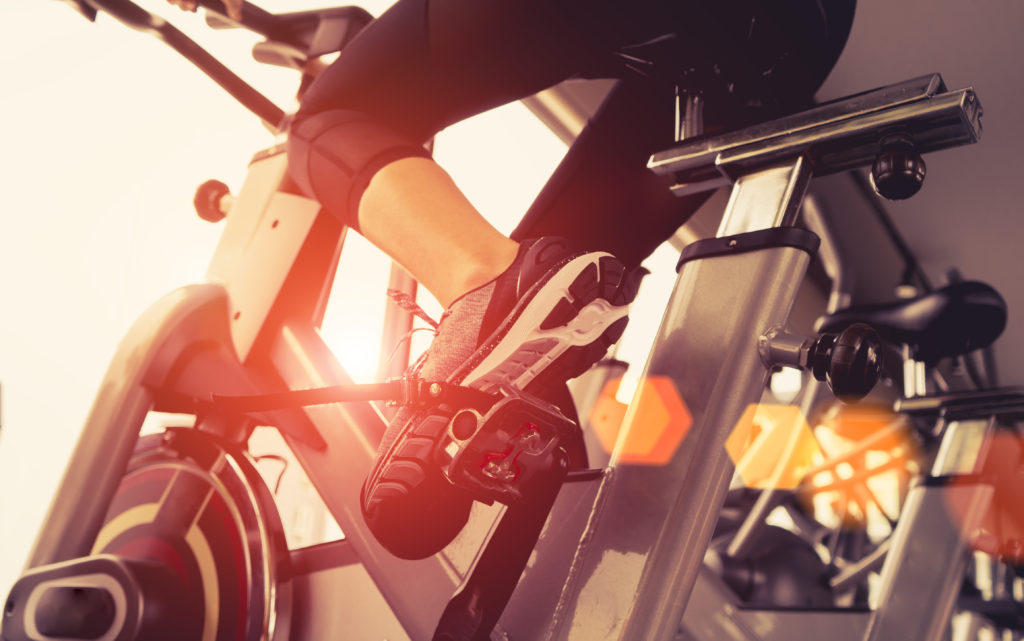
Indoor cycling bikes, commonly known as indoor cycles, can make great additions to any home gym.
Not only can they provide very intense workouts, but they’re compact, easy to move, and they come in all price ranges.
In order to find the best indoor cycle for your needs though, it’s important to have a basic understanding of what makes these exercise bikes tick.
Knowing which features and specs to compare when looking at indoor cycles will make all the difference between you being happy with your new bike and your cycle getting lonely in the corner collecting dust.
Well, this comprehensive review will teach you everything you need to know before you buy anything.
I’ll also present my top bike picks for the year (based on the specs discussed in the buyer’s guide).
After reading this article, you’ll be well equipped to find the perfect indoor cycle for your home gym.
In case you’re in a hurry, I’m going to start with the top indoor cycles, but I encourage you to read the buyer’s guide at the end too – it’s important stuff people!
| Resistance | Frame | Warranty | |
|---|---|---|---|
| #1 Keiser M3i Studio Plus | 8 lb flywheel 72 magnetic levels | 92 lb assembled weight 330 lb weight limit | 3 year frame 3 year parts |
| #2 Original Peloton Bike | 35 lb flywheel 100 magnetic levels | 135 lb assembled weight 297 lb weight limit | 5 year frame 1 year parts 1 year labor |
| #3 NordicTrack X24 Bike | 32 lb flywheel 24 magnetic levels | 205 lb in box weight 350 lb weight limit | 10 year frame 2 year parts 1 year labor |
| #4 Sole SB1200 | 35 lb flywheel 100 magnetic levels | 127 lb assembled weight 300 lb weight limit | Lifetime frame 2 year parts 1 year labor |
| #5 Schwinn IC4 | 40 lb flywheel 100 magnetic levels | 106 lb assembled weight 330 lb weight limit | 10 year frame 3 year parts 1 year labor |
| #6 Sole SB900 | 35 lb flywheel 100 resistance levels | 123 lb assembled weight 300 lb weight limit | Lifetime frame 2 year parts 1 year labor |
The 6 Best Indoor Cycling Bikes of 2026
#1 Keiser’s M3i Studio Plus Indoor Bike
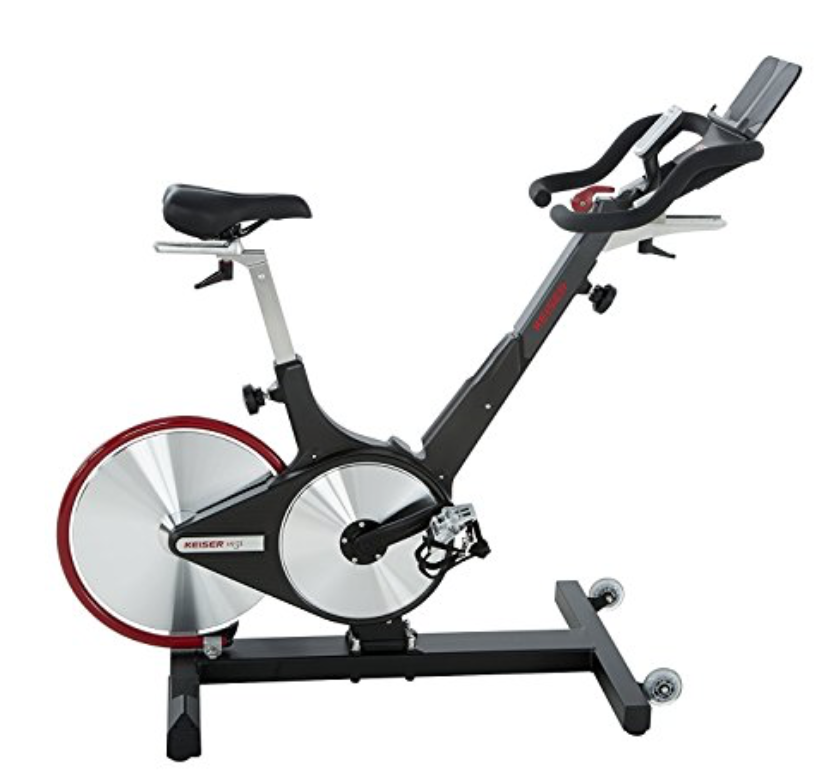
The M3i Studio Plus is Keiser’s newest rendition of their famous M3i (which is still available by the way) and with it, they took their already amazing cycle and made it just a little better.
FYI, Keiser’s OG M3i has been finding its way to the top of “best of” lists for years because there’s really no room for subjectivity here- it’s simply one of the best indoor cycles on the market.
It’s also probably one of the best looking cycles you’re gonna come across – I mean seriously, it looks like a piece of art, gorgeous.
But looks aside, the specs are just as impressive.
Anyway, the M3i Studio Plus is an upgraded version, coming with an updated console and more resistance levels to work with.
More specifically, the Studio Plus comes with 72 gears, giving riders a ton of control over the intensity of their workouts (the older M3i comes with 24).
And the new console is brightly-lit and takes advantage of color coded zones to make training in power zones or heart rate zones more convenient.
It’s also bluetooth/ANT+ compatible with heart rate monitors, fitness apps, projections systems, and pretty much any other device you wanna connect to.
And since its self-generating, you don’t have to worry about messing with batteries or plugging it in.
Oh, and if you purchase the Studio Plus, Keiser throws in a free lifetime subscription to their streaming fitness app, “The Ride”.
The updated console is great, but in terms of performance, the Studio Plus is identical to the older M3i.
This means it uses the same lightweight, rear-mounted flywheel system that made Keiser famous.
And when I say lightweight, I’m talking 8 lb light.
Keiser believes that if your magnetic resistance system and drive train are engineered adequately enough, you don’t need a huge flywheel to achieve a smooth feeling ride.
And users seem to agree because there aren’t any complaints about the feel of this bike.
Instead of using weight to increase the flywheel’s momentum, the M3i Studio Plus uses rotational speed. This bike is designed so that the flywheel spins faster than pretty much any other indoor cycle around.
The result is a smooth feel without the need for a massive flywheel.
With an automotive grade belt drive system and eddy current magnetic resistance, the Studio Plus can provide as smooth and silent a ride as any.
This cycle also comes with a fully adjustable seat, fully adjustable handlebars, and a uniquely designed “V” shaped frame.
Again, this elegant design feature serves an important function- it allows this bike to accommodate users anywhere from 4’10” to 7′ tall.
And with a surprisingly high weight capacity of 350 lb, it guarantees almost anyone can comfortably ride this bike.
I’ve said it in the past, but I still think Keiser could offer a better warranty on this bike.
But the reality is, they still offer one of the better home warranties out there when it comes to indoor cycles.
With a 3 year frame and 3 year parts guarantee, Keiser’s warranty can hang with most (although some brands do still offer a lifetime frame warranty).
The biggest downside here is the cost – this cycle isn’t cheap.
But f you’re looking for an elite indoor cycle that’s built to last a lifetime, Keiser’s M3i Studio Plus is a very smart choice. See full review.
#2 The Original Peloton Bike
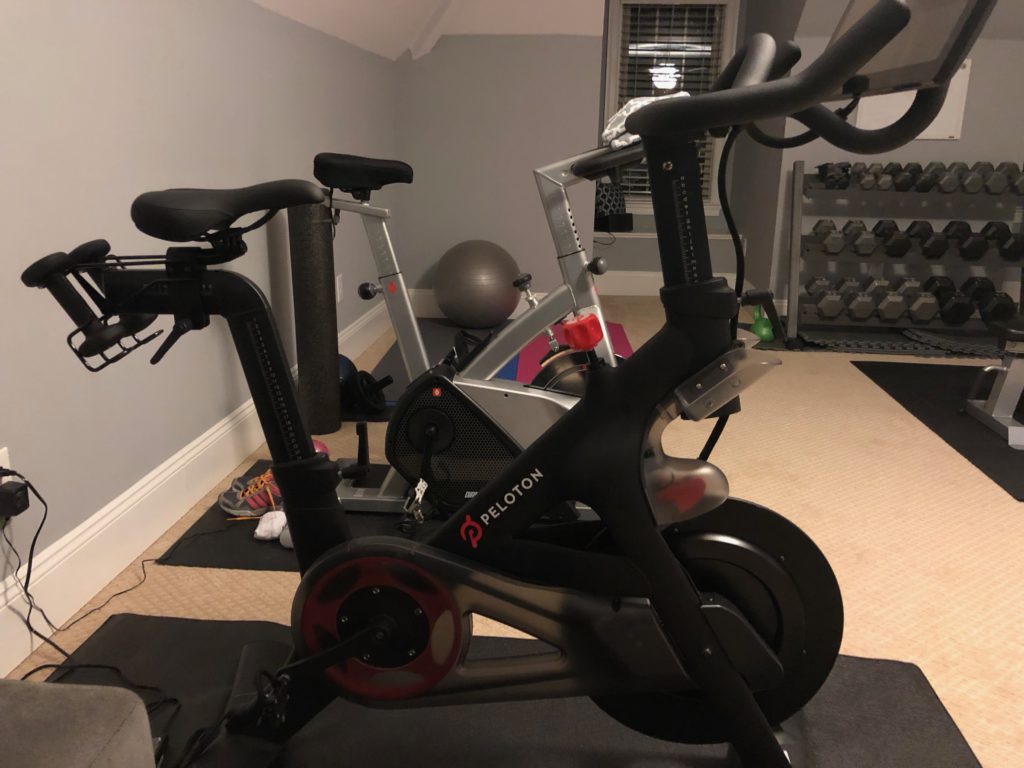
Peloton’s been around since 2012 and for awhile it kinda seemed like they’re taking over the world.
They’ve had their share of issues over the last few years and they’ve got a ton of competition now, but if you ask me, they still offer some of the best home indoor cycles.
Especially their OG Peloton Bike.
I’ve had mine now for about 5 years and it’s still going strong and the instructors are still awesome.
Anyway, the live and on-demand courses are top notch, but the bike itself can hold it’s own with any elite indoor cycle on the market.
With a sophisticated magnetic resistance system and low maintenance belt drive train, the Peloton bike offers a nearly silent ride.
Adjusting the resistance is achieved by easily turning the resistance dial, which is large and easily accessible during workouts.
I like that the resistance is measured in terms of percentage, ranging from 0 – 100 (the total resistance provided is a lot, I rarely get above 60 and that’s with me standing).
This bike uses LOOK Delta clip-in shoes, so cleats are necessary- there’s no shoe cage option for sneakers.
The seat is also fully adjustable, making it easy to find a comfortable riding position.
The only downside (besides having to pay the monthly membership fee) is that the handlebars don’t have a fore/aft adjustment.
Although I’ve never had an issue finding a comfortable riding position.
Otherwise, the Peloton Bike is a class act all around, although the star of the show is obviously the huge, 22″ HD touchscreen console.
Tracking your stats and watching the workouts is a cinch with this beautiful screen.
The system is bluetooth and ANT+ compatible for chest strap heart rate monitors and wireless earbuds.
The warranty could be longer (5 year frame, 1 year parts) but given the quality of this cycle, it’s not a dealbreaker – plus agin, I’ve had mine for years now and it hasn’t skipped a beat (other than my kids breaking my water bottle holder).
And even though there are a ton of streaming cycles to choose from now, I still think Peloton has the best production value with their workouts.
Overall, if you’re looking for a luxury indoor cycle that can turn your own home into a legit cycling studio, the Peloton is the way to go. See full review.
Especially considering how much cheaper it is now, I’ve seen it sell for under $1200 on Amazon before… crazy.
#3 NordicTrack’s X24 Studio Bike
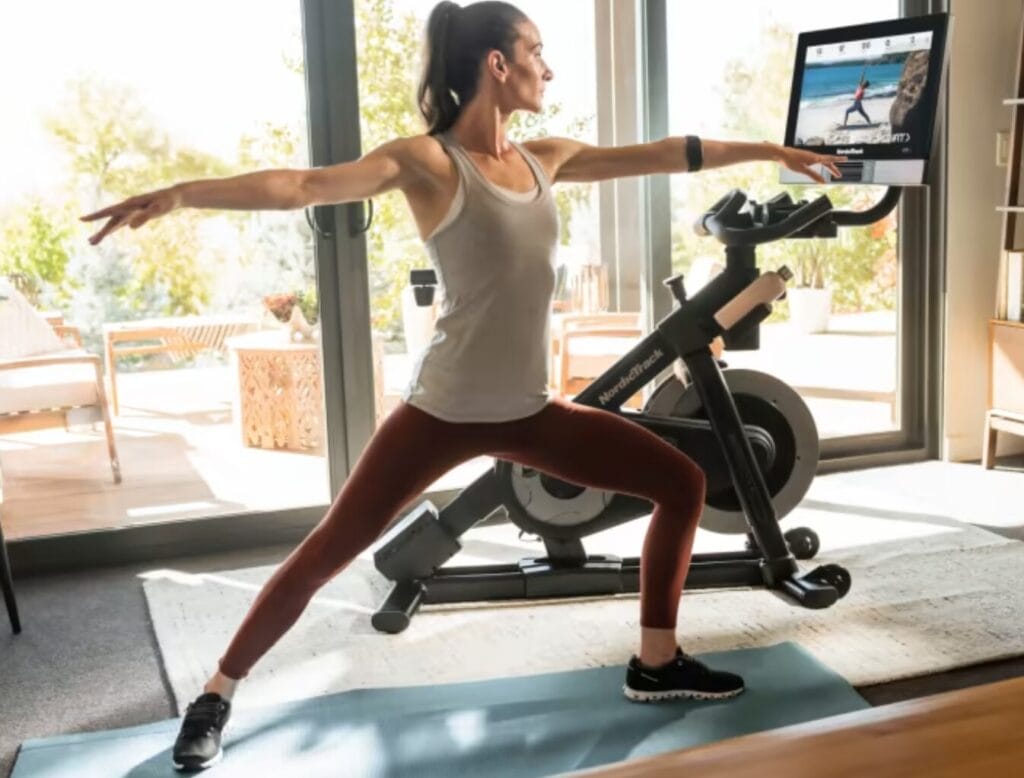
NordicTrack’s another brand that doesn’t really need an intro. They’ve been around forever and are easily one of the most popular fitness brands in the world.
These days, there are a lot of streaming cycles on the market, all trying to capitalize on what Peloton started so many years ago.
But a few years ago, this wasn’t the case.
If I remember correctly, NordicTrack was the first real competitor to Peloton – well, these days it still is.
Like the Peloton, this cycle is designed first and foremost for streaming – that’s what that huge, 24″ HD touchscreen console is for.
NordicTrack uses their streaming service, iFit, for all the instructor-led workouts and since iFit can be used with any NordicTrack product, so if you’re already a member, this bike could make sense.
The X24 has a lot else going for it too besides streaming though.
This cycle comes with a 32 lb flywheel, 24 levels of magnetic resistance, and a heavy-duty frame.
It also comes with a pair of included dumbbells, a built-in fan (something few indoor cycles have), and is bluetooth friendly.
This is all great and whatnot, but what really sets this bike apart is its ability to incline/decline to mimic the feel of riding up/down hill.
I haven’t seen any other bike offer this feature (I’m sure NordicTracks holds the patent).
To make things better, NordicTrack also offers a nice warranty on this cycle: 10 year frame, 2 year parts, 1 year labor.
Overall, if you’re looking for a streaming bike packed full of cool features, NordicTrack’s X24 is a wonderful choice.
P.S.- their S24 is pretty identical, but lacks the incline/decline function, so if you aren’t looking for that feature, you can save some cash by going with the S24.
#4 Sole’s SB1200
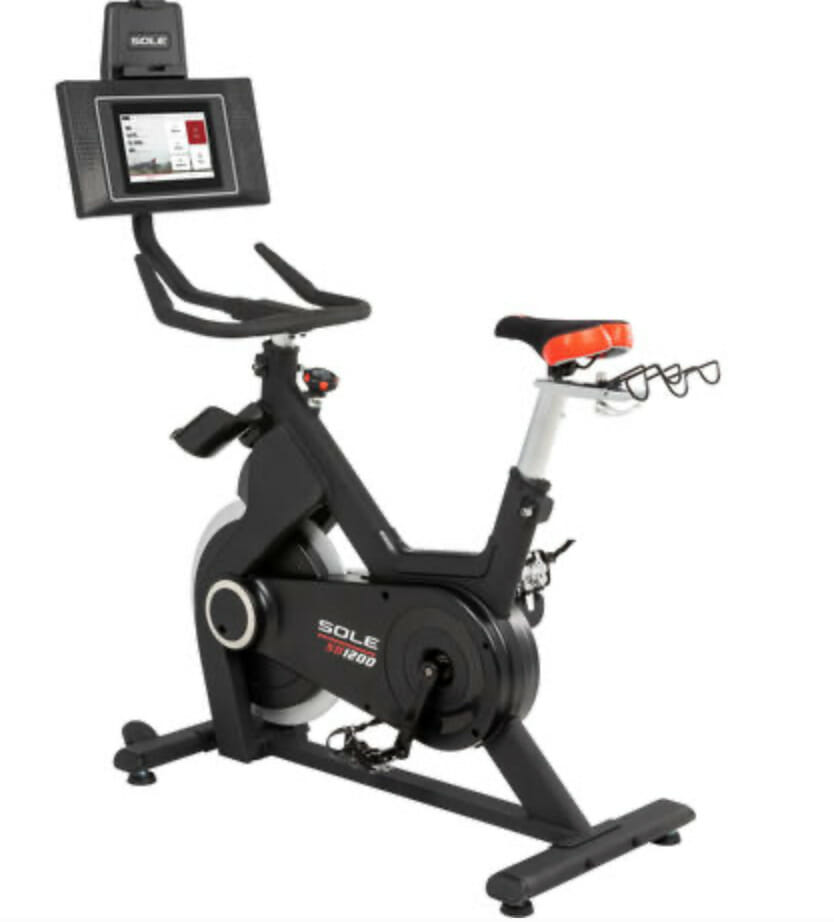
Even though Sole started out producing fitness equipment for hotel chains, they’ve rapidly made a name for themselves in the home fitness game.
You may know them for their popular treadmills, but their indoor cycles deserve just as much praise.
Speaking of which, the SB1200 is the newest addition to their cycling lineup and it’s pretty darn impressive.
Starting from the beginning, this bike comes with a heavy, 35 lb flywheel.
For the cyclists out there that love the feel of a heavy flywheel spinning, this bike is going to make you very happy.
To go along with this heavy flywheel, the SB1200 utilizes a belt drive train and a magnetic resistance system with 100 levels.
The result is a quiet, smooth ride that can compete with any exercise bike in its price range.
And with 100 resistance levels to work with, you get a ton of control over your workouts, but you could also easily follow along with Peloton’s Digital App for a budget-friendlier Peloton hack.
This is probably a good time to mention that this bike only costs around $1500, making it quite affordable for a high end cycle.
To round out this bike, Sole includes a fully adjustable seat and handlebars, making this bike completely customizable.
And with a lifetime frame and 2 year parts warranty, the SB1200 is well covered in case something goes wrong.
The SB1200 also comes with a 10″ touchscreen console that gives you access to built-in entertainment apps, screen mirroring from your phone, and even instructor-led workouts through Sole’s fitness app.
And when you purchase, you get free access to their app, so you don’t have to pay a streaming fee.
Add all this together and I think the SB1200 is easily one of the best buys in cycling at the moment. See full review.
#5 Schwinn’s IC4 Indoor Cycling Bike
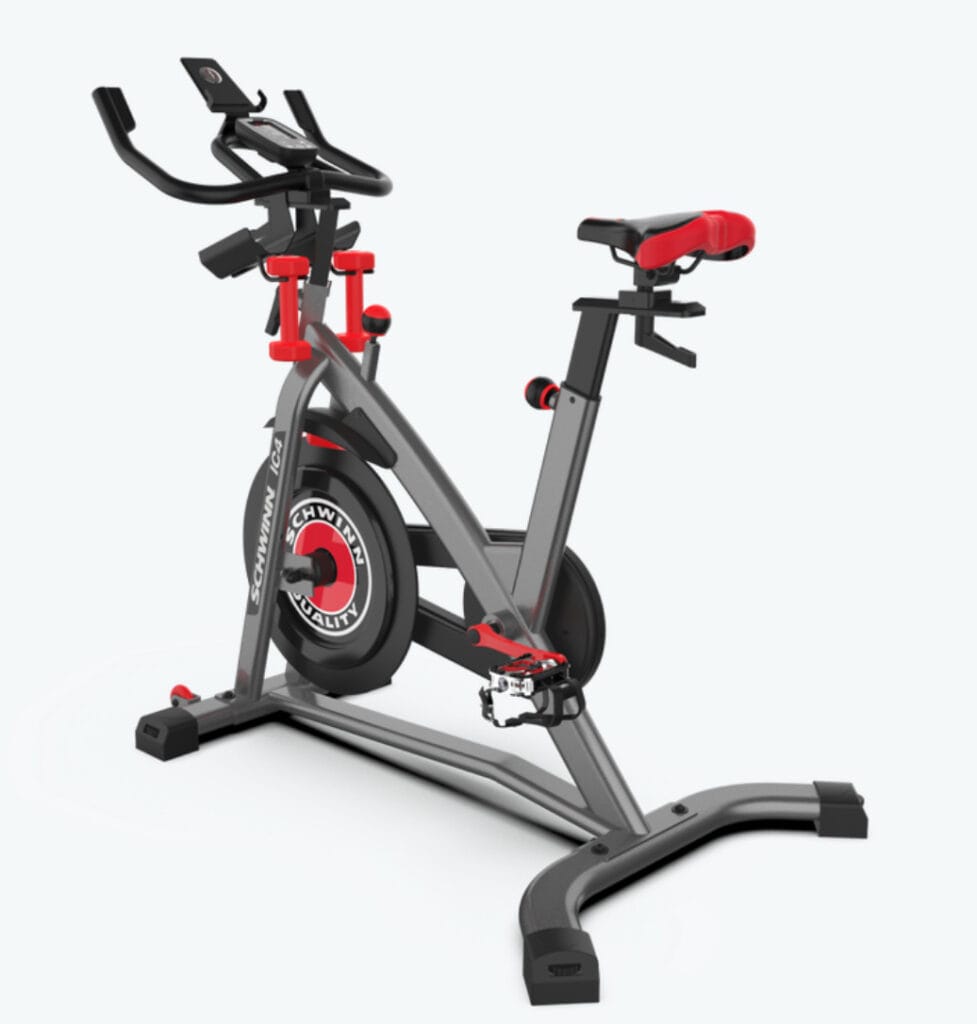
Schwinn lands a bike on this list with their powerful and affordable IC4.
I mean come on – you didn’t think I was going to have a “best bike” list without at least 1 Schwinn on it did ya?
Starting from the top, this cycle has a 40 lb flywheel, which is very heavy for any grade of indoor cycle.
The extra weight helps the IC4 provide a smoother ride than you’d expect from such an affordable cycle too.
This bike pairs that massive flywheel with a magnetic resistance system and then gives you 100 levels to work with.
I love this because this is the same scale Peloton uses with their bike/workouts, meaning it’s really easy to follow along with Peloton workouts with the IC4… just sayin’.
Both the seat and handlebars on this cycle are fully adjustable and the pedals are dual compatible too.
And with a max weight capacity of 330 lb, this affordable bike is adjustable enough to fit just about anyone.
Additional features include a pair of 3 lb dumbbells, a strap heart rate monitor, bluetooth, and a built-in USB charging port.
And to make things even better, Schwinn backs the IC4 with a 10 year frame and 3 year parts warranty.
This bike normally goes for around $999, but I’ve seen it on sale for $799 before. Now that I think about it, maybe the IC4 should’ve been higher up the list? See full review.

#6 Sole’s SB900 Exercise Bike

I mentioned earlier that Sole offers a couple of indoor cycles, well, here’s the other one.
I think it says something when all of a brand’s bikes make my “best of” list…it means Sole knows what they’re doing.
The SB900 is actually very comparable to the SB1200 mentioned earlier – the only real difference is the console.
So, if you like what you heard about the SB1200, but don’t need a fancy touchscreen console, you might love the SB900.
The console on this cycle is very basic – it comes with 9 workout profiles, but otherwise, really just displays your workout stats (not even bluetooth compatible).
But in terms of performance, it’s just as impressive as the SB1200.
This cycle also comes with a 35 lb flywheel, 100 magnetic resistance levels, and a rock-solid frame that can hold users weighing up to 300 lb.
It also comes with dual-compatible pedals, a fully adjustable seat, and fully adjustable handlebars.
And Sole’s warranty here is identical too – lifetime frame, 2 year parts, 1 year labor.
And with an asking price just north of $1k, the SB900 is priced to move.
Overall, if you’re looking for a high-performing cycle but don’t need a fancy console, the SB900 is worth considering. See full review.
Ok, that does it for the bikes, on to the buyer’s guide.
What’s An Indoor Cycle?
Ok, so “spin bike” and “indoor cycle” are two terms for the same product, although “indoor cycle” is actually the proper name for these types of exercise bikes.
Mad Dogg Athletics was the first brand to use the “spin” or “spinning” name for their bikes and they actually trademarked the phrase.
But these days the terms “spin bike” or “spinning bike” have become so generic that they’re often used interchangeably with indoor cycle (even though Madd Dogg is doing their best to ensure the term doesn’t become generic).
Semantics aside, an indoor cycle is a style of exercise bike designed to closely mimic the feel of riding a road bike.
They were created and designed by Johnny G. and John B. who eventually came together to create Mad Dogg- as well as the idea of exercise classes based solely on riding a spin bike.
Johnny G. was an elite cyclist who had an accident while riding at night. Instead of chancing fate again, he decided to come up with a way to ride a road bike indoors.
The rest, as they say, is history.
Key features commonly found on indoor cycles include:
- Heavy flywheels (usually, but not always)
- Standard road bike seats
- Multi-grip handlebars
- The availability of clipless pedals
- Drive trains and flywheels designed for high cadences
Indoor cycles are pretty minimalistic when compared to traditional upright bikes and recumbent bikes.
There’s usually less “stuff” you don’t need to operate the bike (like speakers and cooling fans), although this is changing with so many hi-tech, streaming bikes hitting the market.
P.S.- if you’re looking for a more affordable streaming bike, check out my guide on Peloton alternatives.
Choosing An Indoor Cycle
If you’re new to indoor cycles, that’s ok.
This section will walk you through all the specs and features you should consider when comparing different options.
At first glance, a lot of bikes will appear very similar. In order to find the best buy, you have to take a close look at the fine details.
Flywheel
If you made it through the descriptions of each bike above, you have a good idea of how important the flywheel is to an indoor cycle.
It’s really the heart of the bike- it gives the bike it’s “feel” as well as provides the mechanism to create the resistance.
Flywheels come in all different sizes (all the same shape though, can’t say I’ve ever seen an oval or square one).
The weight of the flywheel is usually the first question people ask when researching a bike.
The traditional belief is that heavier flywheels provide smoother, more realistic rides. These heavier, “perimeter weighted” wheels build more momentum as you pedal.
And this momentum keeps the pedals moving smoothly throughout the entire 360° pedal motion, resulting in a smoother feel.
Cheaper bikes with lighter flywheels can sometimes have “choppy” pedal motions because there isn’t enough momentum to keep pedals moving smoothly.
These days most quality cycles come with flywheels that are at least 30 lb. That seems to be the cutoff of what is considered a “heavy” flywheel.
Don’t ask me who made that rule.
But a lot of brands are including flywheels much heavier, as you may’ve noticed. It’s not uncommon to see 40-50 lb flywheels these days.
I italicized the word “most” above because there’s another school of though that is gaining some serious momentum.
The idea that you need a heavy flywheel to get a smooth ride is being challenged by some of the highest-end brands.
Names like Keiser and ICG are all producing indoor cycles that use flywheels under 10 lb.
The idea being that if you have a sophisticated magnetic resistance system and a properly designed gear system you don’t need all that extra weight to get that smooth feel.
And I can tell you from experience it’s true.
Although I’ve read interviews from elite cyclists who’ve trained with both and still prefer the feel of a heavy flywheel.
According to some, it provides an experience that more closely resembles riding outside.
Regardless of weight, the flywheel is usually found in the front of the bike.
But more and more models now are putting the flywheel in the rear of the cycle- this looks cool, but it also serves to protect the flywheel from sweat damage during use.
We can all thank Keiser for this innovation.
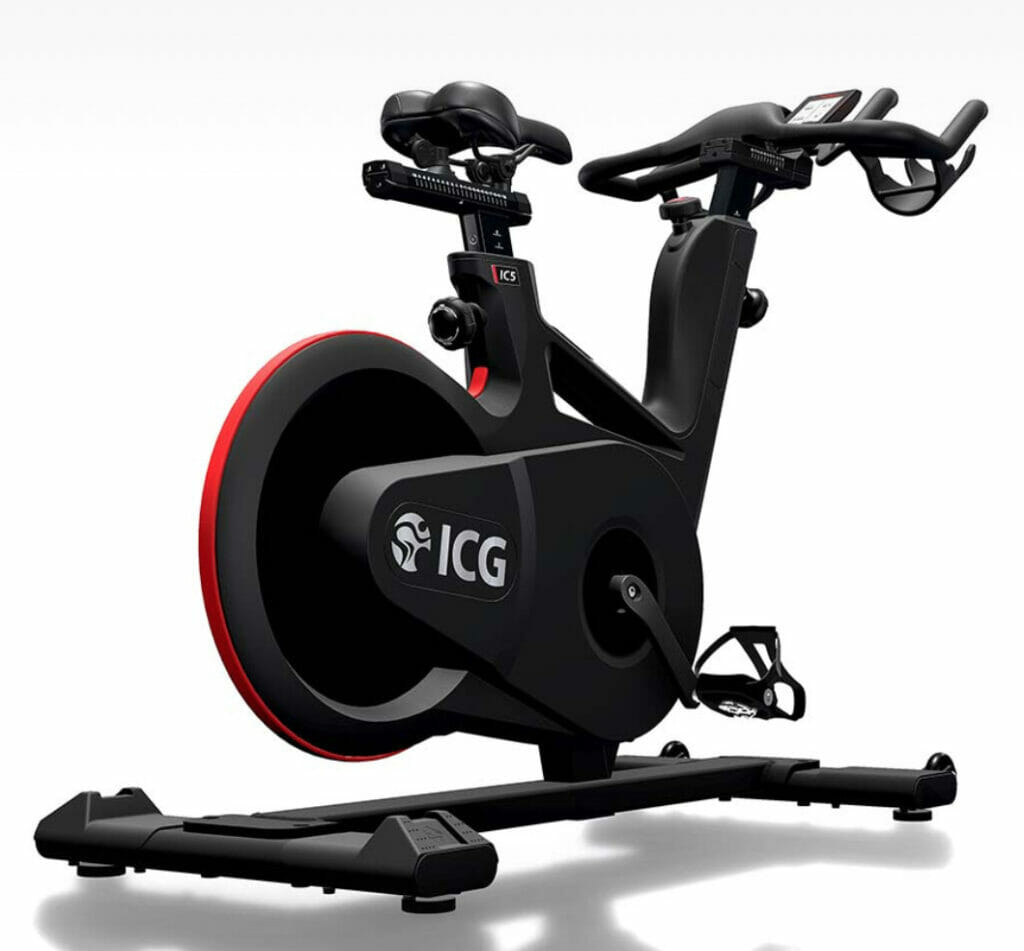
Belt vs Chain Drive
The type of drive train is another spec that you may want to consider. This one isn’t as crucial as flywheel weight, but it can make a difference in your ride experience.
First of all, the drive is what connects the pedals to the flywheel.
On a road bike, this is the chain (chain drive). Indoor cycles also use chains, but now we are also seeing belt drives.
Chain drives work great, but when compared to belts they have a few disadvantages.
First, the chain drives make a little more noise than the belts because you can hear the “clanking” noise the teeth make as the gear catches the chain links.
Belt drives, on the other hand, are basically silent.
Second, chain drives should be lubricated regularly to ensure smooth operation. Most quality belt drives require no maintenance (unless the unlikely should happen and the belt snapped).
Bikes with a belt drive are usually a little more expensive than their chain counterparts, but now even some of the more budget friendly models are starting to use belts.
If you’re looking for the quietest, smoothest ride possible, you should look for a bike with a belt drive.
If you are looking for a bike that works great, but is a little easier on the budget, a chain drive will do just fine.
Keep in mind, chain drives work just as well as belt drives. The noise and maintenance factors are the only difference.
Honestly though, pretty much all indoor cycles these days are coming out with belt drives, so it probably won’t be much of an issue in your search.
Seat
The seats on indoor cycles are usually pretty uncomfortable- that’s just the way it goes. Most indoor cycles use standard road bike seats after all.
Because of their narrow shape, they tend to put more pressure on your bottom than the wider seats used on standard upright bikes.
This is a common truth with all indoor cycles.
The important thing to consider about a bike seat is whether or not it’s fully adjustable.
And fully adjustable means you can adjust the horizontal position of the seat (fore/aft) as well as the height.
Being able to adjust the fore/aft position gives you a much better chance of finding the right fit.
This is especially important on an indoor cycle because you are usually riding at higher speeds and intensities.
If you’re riding often with in improper fit, the chances of you getting injured are more likely.
It’s also not going to feel as comfortable, which could hinder your workouts as well- it’s difficult to go for a long ride when you aren’t comfortable.
Handlebars
The handlebars on an indoor cycle should be multi-grip. This gives you the ability to change the position of your hands throughout your ride.
This is important because you’ll need to change your grip depending on what type of workout you’re doing: your hand position changes depending on whether you’re standing or riding a “flat road”.
Multi-grip handlebars come in all different shapes and sizes.
A lot of handlebars are also fully adjustable (height and fore/aft adjustments possible), although not all are.
If you’re looking for the most customizable fit possible, look for a bike with a fully adjustable handlebar.
Surprisingly, neither of the indoor cycles I own have a fully adjustable handlebar and I’ve been just fine.
Frame
For me, the most important spec regarding the frame is the max weight capacity.
Pretty much all frames are made out of steel and aluminum, but the weight limit gives you an objective measure of how “tough” a bike is.
Higher is always better.
I think you should aim for a bike with at least a 300 lb weight capacity.
Even if you’re only 150 lb, a bike that can handle that much more weight is going to feel a lot more stable during use.
The bikes that can handle users in the 300-350 lb range are more robust and more sturdy- they’re going to feel more like a commercial grade machine when you step up on them.
It’s also a good idea to check out the assembled weight of a bike before purchasing because this tells you exactly how “heavy duty” it is.
Again, heavier bikes are going to feel more stable.
The last thing you want is your bike swaying or wobbling during your workout.
I’ve read reviews where users complain about how heavy their spin bike is. Personally, I want my bike to be heavy.
For me, I like to see an assembled weight of at least 100 lb because this is enough weight to ensure a stable frame (although some cycles with really lightweight flywheels might fall a bit short of this and that’s ok).
Console
If you’re looking for an indoor cycle, the monitor may not be the first thing you consider.
After all, these bikes aren’t historically known for their hi-tech monitors (although of course that’s changing now).
But if you’re stuck between two different bikes, the console may be the tie breaker for ya.
A lot of indoor cycles come with very simple monitors that only consist of a small, LCD screen. Most only track the most basic of metrics, including: time, distance, cadence, speed, and calories.
More advanced consoles are compatible with wireless chest strap heart rate monitors- definitely something you should consider if you like to track your heart rate.
A lot of cycles don’t come with preprogrammed workouts, but some do of course. If you want a bike with workouts included, know that it’s possible to find them.
Some indoor cycles don’t come with a console at all – if you plan to watch tv or watch online workouts, you may not need a monitor.
You can also purchase bike computers separately to track cadence and other metrics.
Every year now, we’re seeing more and more streaming bikes that offer basically unlimited live and/or on-demand workouts (and I don’t think this trend is about to change any time soon).
These streaming bikes can come with hi-tech, touchscreens as well as less sophisticated options.
Regardless of what kind of riding experience you’re looking for, rest assured you can find it.
Warranty
I’m a stickler for warranties regardless of what type of fitness equipment you’re looking for. I think warranty is one of the best indicators of product quality.
Nicer equipment should come with better warranties, although this isn’t always the case.
Indoor cycle warranties are usually broken down into a few different categories:
- Frame
- Parts (sometimes divided into mechanical, electronics, and wear parts)
- Labor
The frame warranty should always be the longest of the bunch. After all, if the bike frame breaks down before anything else you’ve got some serious issues going on.
Good frame warranties should be somewhere between 5-10 years. Great frame warranties are lifetime.
Good parts warranties are 3 years or longer.
Some companies may offer 3 years on the mechanical and electronic parts but only 1 year on the wear parts.
Labor is always the shortest of the bunch because it’s just isn’t cost efficient for companies to be paying third party contractors to re-build their products years after they were purchased.
Even the best warranties rarely have a labor warranty longer than a year or two.
Price (Of course)
I’m a realistic guy.
I know price is usually the first spec we look at when searching for a new anything. The truth is we can only purchase something that fits into our budget.
Luckily, indoor cycles come in a wide range of price points:
- $200 – $500: these are the budget bikes, but that doesn’t mean you can’t get a lot of great features. You can find heavy flywheels and fully adjustable seats and handlebars in this group. Most of these are using chain drives, but some near the $500 range will be using belts.
- $500 – $1000: these are the mid-range bikes and probably where you’re going to get the best bang for your buck. You get a great bike for this budget, including heavy flywheels, magnetic resistances, and belt drives. You can also find great warranties here.
- $1000-$3000: these are the high-end, luxury bikes. Not only should you be expecting pretty much fully-adjustable everything, but in this price range you should expect clipless pedal options and advanced consoles. This price range holds the nicest bikes on the market.
Benefits Of An Indoor Cycle
Now you know what to look for in a spin bike, but is a spin bike right for you to begin with? Maybe I should’ve started with this section.
Oh well.
Indoor cycles offer a great workout.
With their ability to produce heavy resistance and reach high cadences, they are great for interval training and HIIT workouts.
But they are also the least comfortable type of exercise bike. Stationary and recumbent bikes are a lot more comfortable to use.
The heavy flywheels take a little more energy to get started and standing up on them can add extra stress through your knees and hips.
If you have joint issues or are prone to overuse injuries, you may want to think twice before diving in with an indoor cycle purchase.
I would also think twice if you’re just looking for an exercise bike to use for casual workouts – these bikes are designed for intense, calorie torching workouts.
You can obviously workout any way you like with your own bike, but if you aren’t interested in these types of workouts, it might make more sense to go with another type of exercise bike.
But if you are confident you can use one comfortably and are looking forward to some intense bike workouts, an indoor cycle will be perfect for you. The following examples are just some of the benefits you can enjoy:
- They take up very little floor space
- Perfect for burning calories and losing weight
- High resistance levels can built leg strength
- Perfect for improving cardiovascular endurance and health
- Quiet to use
- Wide range of workouts to follow or create your own
- Great for stress reduction
FAQ
Can you switch out the crank arms on an indoor cycle?
Yes you can, and I have.
It’s actually pretty easy on most indoor cycles. You will likely need a crank puller tool, but they are cheap and easy to find.
All you have to do is remove the plug and bolt holding the crank arm attached. Then you will use the crank puller to separate the crank arm from the bike.
There are some great videos on youtube that walk you through it and it only takes a few minutes.
How can I make the seat more comfortable?
There’s really only 2 ways to improve the comfort of a indoor bike seat: replace the seat or add a seat cushion.
Most indoor cycles use standard road bike seats, which means you can easily swap them out for an upgraded seat bought separately.
A cheaper option would be to try a gel seat cushion. I used this one on my Diamondback and it really helped a lot with the comfort.
If you’re new to cycling, do know that with time you will get more used to the feel of the bike and your bottom will get accustomed to riding, which will make it feel more comfortable.
Can the pedals be switched out?
Yup, they sure can.
Just like the seat, any quality spin bike will be using standard pedals that can easily be swapped out for another pair of your choosing.
This comes in especially handy if you find a great bike you love, but the pedals aren’t compatible with cleats.
Instead of starting your search all over, you could purchase your favorite bike and simply swap out the pedals.
Can indoor cycles be assembled by 1 person?
I guess this really depends on your size and level of handiness. But generally speaking- yes, most of these bikes are pretty easy to assemble with only 1 person.
The flywheel/drive train component all comes fully assembled. You basically have to attach the stabilizers, handlebars, seat, pedals, and console.
Depending on how advanced your console (monitor) is, you may have to snake a wire through the handlebars and make a few connections.
Most indoor cycles can be fully assembled within 30-60 minutes.
How heavy are indoor cycles?
This depends on the make and model, but generally speaking, most quality cycles weight between 90 – 140 lb.
Keep in mind the flywheel alone on some of these bikes weighs 40 or so pounds.
This makes them a little front heavy, so keep that in mind when moving them. They all come with transport wheels, which makes moving them a lot easier too.
You just have to tilt them forward on the wheels and wheel them to their next location.
How much floor space do indoor cycles take up?
This may vary a little depending on the bike, but most spin bikes only require a footprint of roughly 4′ (L) x 2′ (W).
This makes them amongst the smallest types of home fitness equipment and great for homes with limited space.
What type of maintenance is necessary on an indoor cycle?
All brands will have specific instructions for their bikes when it comes to maintenance.
Generally speaking, you should wipe any sweat off the bike after each use because it can be corrosive to the frame and parts.
You should also make sure all bolts are checked periodically to ensure nothing is coming loose, including the pedals (I had an issue with one of my pedals on the Diamondback that probably could’ve been avoided if I had checked them regularly).
If your bike has a chain drive, you should lubricate periodically to keep it running smoothly. Belt drives shouldn’t require any lubrication.
Otherwise, check the user manual for specifics.
What heights can a cycling bike comfortably accommodate?
This varies greatly on the make and model of the bike, but most indoor cycles can comfortably accommodate people anywhere from 5’2″ to 6’4″, but we’re all built differently.
Checking the inseam height availability of the seat can give you a good idea.
The Keiser M3i claims that because of its unique V-shaped frame, it can hold folks anywhere between 4’10” and 7′ tall- which is pretty remarkable.
Final Thoughts
Well, there ya have it.
I’ve said it before, but I might as well say it again – it’s not easy making these lists.
There are just so many great cycles out there, it really is difficult to narrow it down to the best options around.
Anyway, with the above list, I tried to keep both performance specs and price in mind when picking which cycles I wanted to include.
There are plenty of great bikes that didn’t make this list, but I think the above cycles represent the best options the home market has to offer this year.
Anyway, I hope you found this guide helpful and at least a little entertaining.
And as always, if you have any questions or comments, leave ’em below and I’ll get back to you shortly.





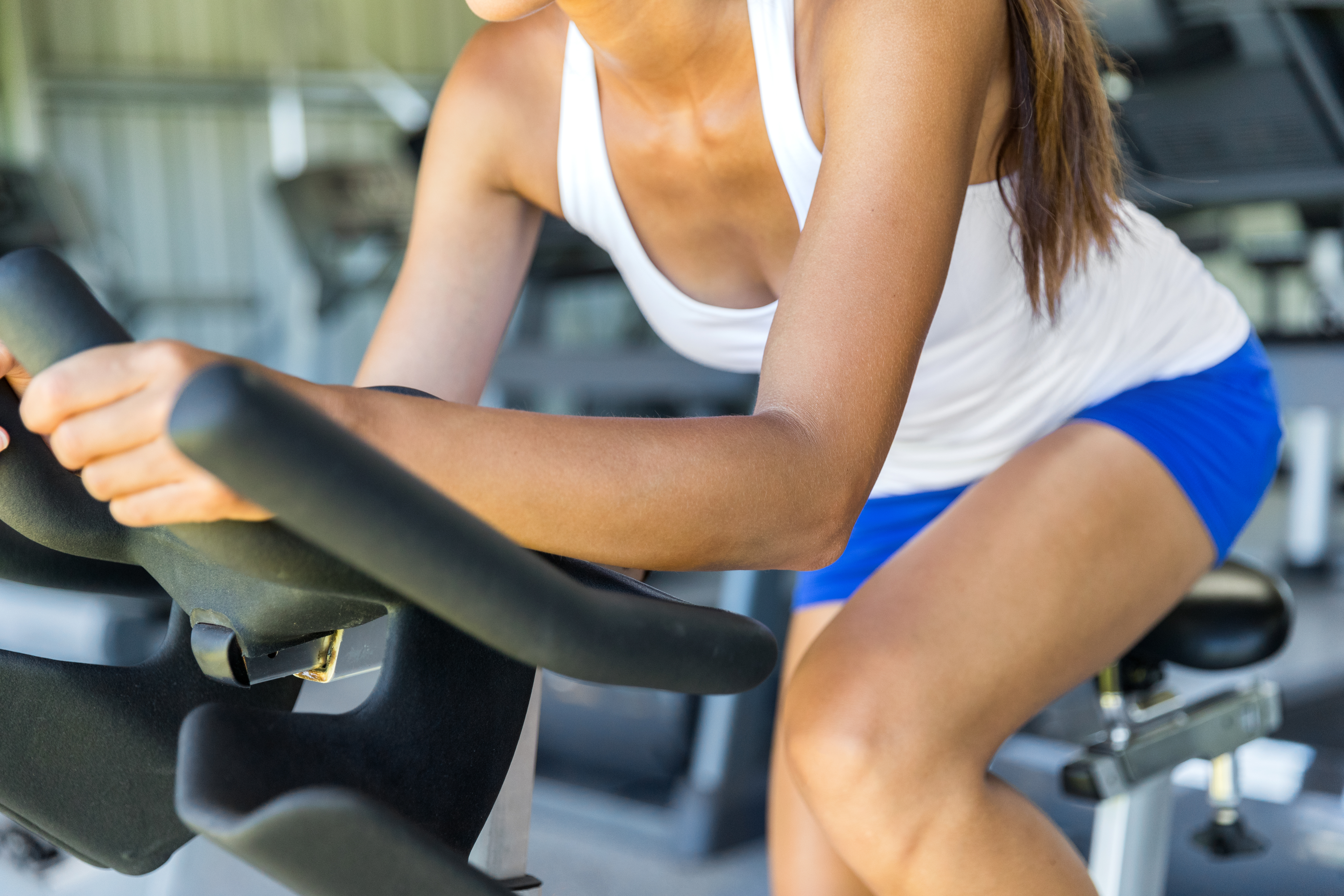
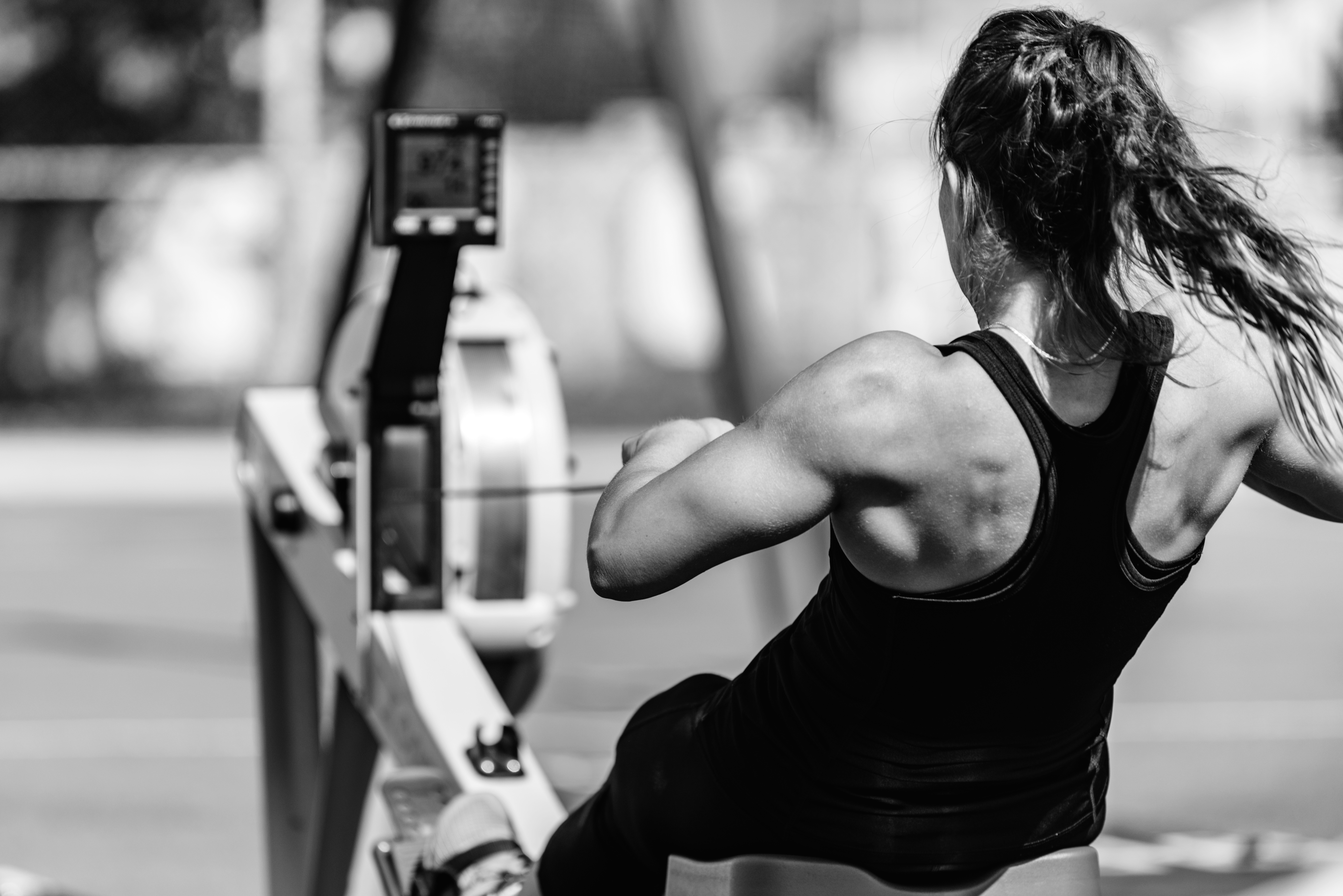
Will, I am seriously considering the ICG Ride CX (I get a discount from my employer). I’ve been using the Peloton app ($12.99/month) with various bikes, including a ICG7 in a gym, with a road bike on a trainer, and would do the same with the CX. Do you know if there is a resistance/cadence conversion between ICG and Peloton? I am very interested in figuring out power zones for Peloton rides.
Great question, and it’s always great to hear from another Peloton user! I’m not aware of any specific resistance/cadence conversions between Peloton and ICG, but the good news is, I don’t think you really need one. The Peloton and the ICG Ride both use 100 resistance levels, so that should make it fairly easy to follow the Peloton instructors’ cues regarding resistance settings during workouts. And since cadence is simply a measurement of your RPMs, that should correlate accurately between the 2 bikes as well. And keep in mind, with the power zones, it’s all about watt output – and since the ICG’s console does measure watt output, you’d really just have to match your watt output to match whatever power zone the workouts are telling you to be in at any given time. So, unless I’m missing something, I think it would be pretty straightforward to follow along with the Peloton power zone workouts using the Ride CX.
Thanks so much for the quick response, appreciate your insights on both the bike and treadmills.
My pleasure, thanks for reading!
If Peloton would sell their bikes, without the screen (replaced by a basic metric device like other brand), and without all that membership thing, I would pay 600$ for the bike (with device) because many of us don’t need the let’s go all together thing. We just need to spin. So they could sell more of those. Even the used items are out of price.
Yeah, I hear ya, it’s certainly not for everyone. But the whole streaming experience is what Peloton’s really all about, without that (and the HD console and whatnot) and Peloton’s not particularly special. The bike itself is nice and offers a great ride, but again, I think it’s their streaming service that really steals the show. I think you’ve got a good idea though, I like the idea of Peloton offering bikes without the huge console.
Hi Will, am surprised the Concept2 bikeerg did not make your list, what are your reasons? Thanks.
Yeah, tough call. Ultimately, I didn’t include the BikeErg because of the unconventional air fan resistance system which could defer a lot of beginning riders. But I think one could easily argue that it deserves a spot. With so many great bikes, it can be hard to narrow it down.
I need help choosing an exercise bike. I am 78 and need a bike to stay fit but I want something that has a comfortable seat. A 10 to 20 minute work out that would help to get my legs stronger. I have two knee replacements also. I also have drop which makes walking difficult. My PT said a bike would be best.
It sounds like a recumbent bike might be the best option for ya, as they work great for rehab purposes. Here’s my guide on recumbent bikes if you’d like to check it out. When choosing one for your home, it really depends on how much you’re looking to spend. More expensive bikes tend to offer smoother pedaling motions and more challenging workouts, but if you’re simply looking for a comfortable bike to help get those knees moving more, I don’t think you’d have to spend a ton of money on one. Nautilus’ R618 is a great recumbent that’s backed by a long warranty and well priced at well under $1k; Diamondback’s 910Sr is heavier-duty and also very well priced at the moment. Again, kinda depends on what features and whatnot you’re looking for. Hope that helps!
Great reviews Will. I have learned so much about these bikes from your write up.
Peloton sounds wonderful. But I’m really not into being forced to join their $39 program so I can use a bike. The BowFlex is out for us because two of us are on the taller side. Do you know if the apps on most of the other bikes can be operated on a Smart Tv? Also, I always wonder about the financial interests of reviewers and whether or not they are paid to put out a positive review. (No offense meant, it is just the way of the world today).I see then Amazon connection. Is there more? Thanks again for these reviews.
Yeah, I know, the $39 monthly fee for Peloton kinda sucks. When it comes to fitness apps on Smart TVs, I have to admit I don’t have much experience because I’ve never tried. If you have an Apple Tv, you’d be able to access most of these apps because they’re all compatible with Apple devices. But when it comes to Samsung and all the other brands, I’m not sure. I know there are a ton of spinning apps out there that aren’t affiliated with these fitness brands as well that may be accessible through tvs. You bring up a valid point regarding the financial interests of reviewers and positive reviews- as an affiliate, I do get paid a fee if you purchase something through one of the links on my site (I’m affiliated with Amazon, as well as several other fitness brands). Personally, I try to be as honest and upfront about this as possible and I try to keep my reviews as honest as possible. That’s why I try to educate my readers about the things they should be looking for when searching for fitness equipment (so they don’t have to just take my word for it that something is “good”). But a lot of review sites don’t. I’ve read plenty of fitness review sites that give everything a positive review- a prime example related to spin bikes is when a reviewer talks about how awesome the “heavy, 12 lb flywheel” is- I mean, give me a break. Sorry for the rant, but to get back on point, I think you’re correct to be suspicious of reviews you read online- always do your homework and compare those specs! Thanks for reading! (and sorry I wasn’t much help with the tv apps)
I need an indoor cycling bike. The problem is that I need it already assembled. Please advise and thanks.
I’m not familiar with any bikes that come 100% pre-assembled- any quality bike is going to require a little assembly. If you or a family member isn’t able to assemble, many times you can pay for professional assembly. If that isn’t possible, you could always go with a pedaler, which is basically like a small exercise bike, but without a seat (so you can place it in front of any seat you like). Pedalers aren’t nearly as nice as full exercise bikes, but they can be better than nothing. Sorry, I wasn’t more help. Good luck!
hey debbie, you should go with the lifefitness ic5. it`s a great bike, and some of the high-end bikes offer assembly, at additional charge.
hey debbie, i have an update. lifefitness has a servicethat`s called “white glove delivery and install”. lifefitness said, “our installers will call you to set up a time to assemble and install your equipment and clean up any excess material.